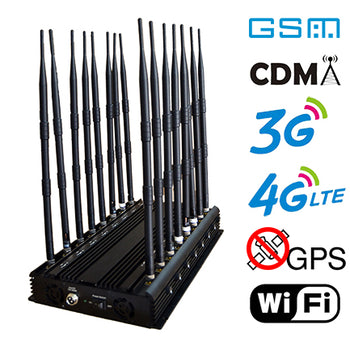How to Test Cell Phone Signal Strength and Choose the Right Cell Phone Jammer
dBm is a value that evaluates the absolute value of power, and the calculation formula is: 10lgP (P=power value/1mw).
[Example 1] If the transmit power P of the signal jammer is 1mw, it is 0dBm after converting to dBm.
[Example 2] For a power of 40W, the converted value in dBm should be:
10lg(40W/1mw)=10lg(40000)=10lg4+10lg10+10lg1000=46dBm.
Remember: -70dBm is equal to 10 to the tenth power of a watt, which is one billionth of a watt. Therefore, when using the logarithmic form of dBm to represent extremely small or extremely large power, it is not only very effective, but also the original multiplication calculation is converted into a simple addition calculation.
1.4.2 dB
dB is a value that characterizes the relative value. When considering how many dB the power of A is larger or smaller than the power of B, the following formula is used: 10lg(A power/B power)
[Example 3] A's power is twice as large as B's power, then 10lg(A's power/B's power)=10lg2=3dB. That is, A's power is 3 dB greater than B's power.
[Example 4] The 100-meter transmission loss of a 7/8-inch GSM900 feeder is about 3.9dB.
[Example 5] If A's power is 46dBm and B's power is 40dBm, then it can be said that A is 6 dB larger than B.
[Example 6] If antenna A is 12dBd and antenna B is 14dBd, it can be said that A is 2 dB smaller than B.
The effective coverage of a base station is determined by factors such as the transmit power of the base station, the gain of the antenna, and its height angle, which is generally several kilometers. Due to the large number of mobile phones per unit area in the city, the distribution of base stations is relatively dense. Cells in the cell can communicate on the same frequency.

The signal will be attenuated during the propagation. The most basic mechanisms that affect propagation are reflection, diffraction, and scattering.
Reflections occur when electromagnetic waves encounter objects larger than the wavelength, such as the surface of the earth, buildings and walls.
Diffraction occurs when the wireless path between reception and transmission is blocked by a sharp edge, and the secondary waves generated by the blocking surface are dispersed in space, even on the backside of the blocking body. When there is no line-of-sight path between reception and transmission, wave bending also occurs around the barrier.
Scattering occurs when there are objects smaller than the wavelength in the medium through which the electromagnetic wave travels and the number of blocking objects per unit volume is very large, which often occurs on rough surfaces, small objects or irregular objects. In a practical communication system, leaves, street signs and lamp posts etc. cause scattering.
Signal propagation generally undergoes the following forms of attenuation:
Free space attenuation: L=32.4+20logd+20logf (d in kilometers, f in megahertz)
Obstruction attenuation: reinforced concrete structure: ≥28dB
Brick wall structure: ≥20dB
Wooden wall, gypsum keel wall: ≥10dB
Anti-theft net: ≥20dB
Glass curtain wall, doors and windows: ≥3dB













